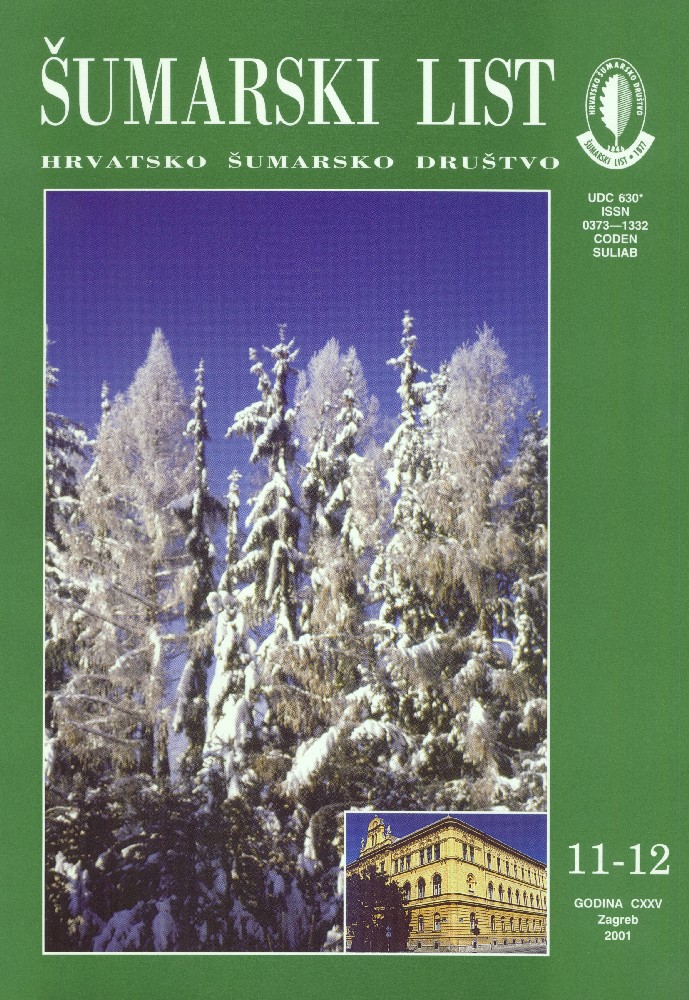| |
| IZVORNI ZNANSTVENI ČLANCI |
| |
|
|
| Matić, S., Rauš, Đ., Seletković, Z., Španjol, Ž., Anić, I., Oršanić, M., Tikvić, L., Baričević, D. | UDK 630* 189 + 269 + 41 : 907.1 (001) |
| A Contribution to Knowing the Forests and Forest Vegetation in Kornati National Park and Telašćica Nature Park
pdf
HR
EN
|
583 |
| Krapinec, K. | UDK 630* 156 + 262 (001) |
| The Importance and Role of Plant Species from Open Strips in the Eu-Mediterranean as a Nutritive Potential for the Growth of Big Game
pdf
HR
EN
|
599 |
| Posavec, S. | UDK 630* 652 + 909 (001) |
| A Discussion on the Methods of Assessing Forest Values
pdf
HR
EN
|
611 |
| |
| PREGLEDNI ČLANCI |
| |
|
|
| Krpan, A. P. B., Poršinsky, T. | UDK 630* 369 + 37 |
| Harvester Timberjack 1070 in Croatia
pdf
HR
EN
|
619 |
| Frković, A. | UDK 630* 156 (Lynx lynx L.) |
| The Lynx (Lynx lynx L.) in Croatia - Reintroduction, Catch and Population
pdf
HR
EN
|
625 |
Summary: Eurasian lynx (Lynx lynx L.) was reintroduced into Croatia by releasing three pairs of animals of Slovakian urigin from the quarantine in Kočevsko (Slovenia) on 2 March 1973. (The last autochthonous lynx in Croatia was killed in 1903.). The first adult specimen was seen in Risnjak National Park on 16 June 1974. Since then the data on the course of reintroduction, abundance, damages and mortality have been continually collected. From the Čabar section of Gorski kotar the lynx gradually spread in direction southeast. By the end of 1970s they inhabited the whole Gorski kotar and greater part of Hrvatsko primorje, beginning to exhibit the first bigger reduction effects on the populations of hoofed game (roe deer, chamois, moufflon). Since the first individual was killed in the hunting area “Snježnik” on 27 September 1978 the illegal hunting has been on rise. To prevent in the lynx was protected in 1982 by the Law of nature protection. However, the yearly hunting quotas have been regularly assigned to local authorities. In total the mortality of 211 lynxes over 23 years (1978 to 2000) has been recorded. Most lynxes died in Primorsko-goranska county; 135 (64 %), followed by Ličko-senjska county with 56 (26 %) and Karlovac county with 11 (5 %) lynxes. Lynx is today present in almost all mountainous forest and other adequate habitats above 600 meters above sea level. The population size is estimated between 70 and 90 individuals. However, some recent analyses based on prey availability indicate the lynx population below 50 specimens. Although the system of quota hunting has been questionable for the legally protected animal species, this survey shows that the recorded mortality did not prevent the spreading of lynx to adequate habitats in Croatia and its dispersal to Bosnia and Herzegovina. However, the future of lynx might not be safe without a sound management.
Key words: Croatia; Eurasion lynx; hunting; Lynx lynx; management plan; mortality; population size; reintroduction |
| |
| STRUČNI ČLANCI |
| |
|
|
| Bezak, K. | UDK 630* 567 |
| Parameters of Volume Tables by Špiranec for Usable Timber of Pedunculate Oak (Quercus Robur L.), Sessile Oak (Quercus Petraea L.) and Common Beech (Fagus sylvatica L.)
pdf
HR
EN
|
635 |



